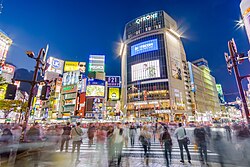Shibuya Crossing
You can help expand this article with text translated from the corresponding article in Japanese. (December 2020) Click [show] for important translation instructions.
|
Shibuya Crossing | |
|---|---|
| Scramble crossing | |
 Shibuya scramble crossing at night | |
| Location | Shibuya, Tokyo, Japan |
| Coordinates: 35°39′34″N 139°42′02″E / 35.65950°N 139.70056°E | |
Shibuya Scramble Crossing (渋谷スクランブル交差点, Shibuya sukuranburu kōsaten), or commonly known as Shibuya Crossing, is a popular scramble crossing in Shibuya, Tokyo, Japan.[1] It is located in front of the Shibuya Station Hachikō exit and stops vehicles in all directions to allow pedestrians to inundate the entire intersection. The statue of Hachikō, between the station and the intersection is a common meeting place and almost always crowded.
Three large TV screens mounted on nearby buildings overlook the crossing, as well as many advertising signs. The Starbucks store overlooking the crossing is also one of the busiest in the world. Its heavy traffic and inundation of advertising have led to it being compared to the Times Square intersection in New York City and Piccadilly Circus intersection in London. Shibuya Crossing is the world’s busiest pedestrian crossing, with as many as 3,000 people crossing at a time.[2][3][4] Tokyo-based architecture professor Julian Worrall has said Shibuya Crossing is "a great example of what Tokyo does best when it's not trying."[5]
Cultural depictions and media usage
Shibuya Crossing is often featured in movies and television shows which take place in Tokyo, such as Lost in Translation,[6] The Fast and the Furious: Tokyo Drift, and Resident Evil: Afterlife, as well as on domestic and international news broadcasts. The iconic video screen featured in the above movies, in particular Lost in Translation with its 'walking dinosaur' scene, was taken down for a period of time and replaced with static advertising, although it resumed operation in July 2013.[7]
Contemporary British painter Carl Randall (who spent 10 years living in Tokyo as an artist) depicted the area in his large artwork 'Shibuya', exhibited at the National Portrait Gallery in London 2013.[8][9][10] Scramble Crossing is a major location in the video game The World Ends With You and its sequel, which is set entirely in the neighbourhood of Shibuya.[citation needed]
Foot traffic

This intersection is frequently called "the busiest pedestrian intersection in the world"[2][3] and there is almost no loss of foot traffic at midnight or early morning.[11] Road traffic jams rarely occur here even during rush hours.[3]
According to the Shibuya Center Street in 2016, the number of pedestrians crossing the intersection was as much as 3,000[2] per green light (every 2 minutes[12]). A 2014 flow measurement survey by the Shibuya Redevelopment Association estimated 260,000 pedestrians per day on week days, and 390,000 pedestrians on non-working days.[2] Others estimate as much as 500,000 people on the busiest days.[13] The 2012 SOTO Outdoor Media Survey estimated 1.5 million pedestrians per week.[14]
History
The crossing was inaugurated in 1973.[15]
The crossing was featured in the 2016 Summer Olympics closing ceremony to promote the 2020 Summer Olympics in Tokyo.[16][17]
Since the late 2010s it has become a popular place for young people to gather at Halloween, some in cosplay costumes. Increasingly large and chaotic crowds led in 2019 to Shibuya Ward adopting an ordinance banning alcohol consumption in the area at the end of October.[18]
References
- ^ Murray Buechner, Maryanne. "Tokyo: 10 Things To Do". Time: Travel. Archived from the original on August 19, 2019.
- ^ a b c d 井上恵一朗 (2016-04-22). "【東京はてな】 渋谷交差点、1回で3千人横断?". 朝日新聞. p. 29.
- ^ a b c "渋谷スクランブル交差点――世界で最もワイルドな交差点にようこそ". CNN.co.jp. 2019-08-25. Archived from the original on September 23, 2020. Retrieved 2019-09-26.
- ^ "The World's Busiest Pedestrian Crossing". WorldAtlas. Archived from the original on August 12, 2020. Retrieved 2020-04-13.
- ^ Nakagawa, Ulara. "15 sights that make Tokyo so fascinating". CNNGo.com. Archived from the original on 1 November 2012. Retrieved 3 December 2011.
- ^ Glionna, John M. (2011-05-23). "Japan's orderly Shibuya Scramble". Los Angeles Times. Retrieved 2011-08-28.
- ^ 渋谷駅ハチ公口交差点前「QFRONT」ビル壁面の大型ビジョン「Q’S EYE」をリニューアル!(2013/7/11). Tokyu. 2013-11-07. Archived from the original on 2013-09-18. Retrieved 2014-02-07.
- ^ BBC World Service: World Update. 'Carl Randall - Painting the faces in Japan's crowded cities'., BBC, 2016
- ^ 'Carl Randall's Japan - the best BP Travel Award Exhibition ever!'., Making a Mark, London, 2012
- ^ 'Shibuya drawing'., Carl Randall artist website, 2012
- ^ 内山理名. "内山理名のTokyoフォトアルバム File16 (Japanese book)". 東京ウォーカー (2000年10月17日号). 角川マガジンズ: 85.
- ^ 伊藤隆太郎 (2016-03-05). "【みちのものがたり】 外国人を引きつける渋谷スクランブル交差点 - 猥雑で混沌とした近未来都市". 朝日新聞 be. p. e2.
- ^ "渋谷スクランブル交差点の楽しみ方". JOURNEY of JAPAN. 三井住友カード. 2018-08-02. Retrieved 2019-04-07.
- ^ "渋谷駅ハチ公口交差点前「QFRONT」ビル壁面の大型ビジョン「Q'S EYE」をリニューアル!" (PDF). 東京急行電鉄. 2013-07-11. Retrieved 2019-04-07.
- ^ The Asahi Shimbun March 9th 2016 issue
- ^ Palazzo, Chiara (August 22, 2016). "Shinzo Abe emerges from a green pipe disguised as Super Mario during Rio Closing Ceremony". Retrieved August 22, 2016.
- ^ Samuelson, Kate (August 22, 2016). "Shinzo Abe Dresses as Super Mario for Rio Closing Ceremony". TIME.com. Retrieved August 22, 2016.
- ^ "Halloween in Shibuya: Mayhem ensues despite increased security and ban on alcohol". The Japan Times. 2019-11-01. Retrieved 2021-01-26.

